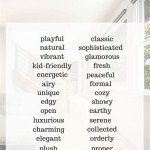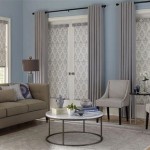Interior Design Firms in Miami: Navigating Style and Function
Miami, a city synonymous with vibrant culture, stunning architecture, and a thriving luxury market, demands exceptional interior design. Numerous firms operate within the city, each offering a unique approach to transforming spaces into functional and aesthetically pleasing environments. Selecting the right interior design firm is crucial for homeowners, developers, and businesses seeking to elevate their surroundings and reflect their individual or brand identity.
The interior design landscape in Miami is diverse, encompassing a wide range of styles and specializations. From minimalist modern aesthetics to opulent, resort-inspired designs, firms cater to various tastes and project requirements. Understanding the nuances of these firms, their design philosophies, and their project management capabilities is essential for making an informed decision. This article will explore key factors to consider when evaluating interior design firms in Miami, highlighting the importance of expertise, collaboration, and a proven track record.
Understanding Miami's Design Landscape
The geographic location and cultural influences of Miami have shaped its distinct design aesthetic. A blend of art deco, Mediterranean revival, and contemporary influences creates a unique architectural backdrop. Interior design firms operating in this environment must possess a thorough understanding of these styles while also embracing modern trends and innovations. The city's emphasis on outdoor living necessitates designs that seamlessly integrate indoor and outdoor spaces, often incorporating natural light, lush greenery, and durable materials capable of withstanding the tropical climate. The high-end real estate market in Miami also demands a focus on luxury, utilizing premium materials, custom furnishings, and cutting-edge technology to create truly exceptional living and working environments.
Furthermore, the diverse cultural makeup of Miami influences design preferences. The city is a melting pot of Latin American, European, and American cultures, each contributing to a rich tapestry of aesthetic sensibilities. Successful interior design firms in Miami are adept at understanding and incorporating these diverse influences into their designs, creating spaces that resonate with a wide range of clients. This adaptability is particularly important when working on residential projects, where reflecting the homeowner's personal style and background is paramount.
The competitive nature of the Miami market necessitates that interior design firms stay abreast of the latest trends and technologies. This includes incorporating smart home automation, sustainable design practices, and innovative materials. Firms that invest in continuing education and professional development are better equipped to offer clients cutting-edge solutions and ensure their projects are both aesthetically pleasing and functionally efficient.
Key Considerations When Choosing a Firm
Selecting an interior design firm requires careful consideration of several factors. These factors include the firm's expertise, design philosophy, project management capabilities, and client communication skills. Thoroughly evaluating these aspects will help ensure a successful collaboration and a final product that meets or exceeds expectations.
Before engaging with any firm, a potential client should carefully review their portfolio. A portfolio provides a visual representation of the firm's design style, range of expertise, and quality of workmanship. Look for projects that align with your own aesthetic preferences and project requirements. Pay attention to the level of detail, the use of materials, and the overall cohesiveness of the design. A well-curated portfolio should demonstrate the firm's ability to translate diverse client visions into tangible realities.
Equally important is understanding the firm's design philosophy. This encompasses their approach to problem-solving, their commitment to client collaboration, and their understanding of the project's specific needs. Some firms may prioritize minimalist aesthetics, while others may favor more elaborate and ornamental designs. Clarifying these philosophical differences early in the process can help avoid misunderstandings and ensure a harmonious working relationship. Discussing the firm's approach to sustainability, accessibility, and budget management is also crucial for ensuring the project aligns with your overall goals.
Beyond aesthetics, project management is a critical aspect of any interior design project. Inquire about the firm's processes for managing timelines, budgets, and communication. A well-organized firm will have established systems for tracking project progress, coordinating with contractors and vendors, and addressing any unforeseen challenges that may arise. A clear communication protocol is essential for keeping clients informed and involved throughout the design process. Regular updates, site visits, and detailed documentation can contribute to a smoother and more transparent project execution.
Client testimonials and references provide valuable insights into the firm's reputation and past performance. Contact previous clients to inquire about their experience working with the firm. Ask about the firm's responsiveness, problem-solving skills, and overall professionalism. Positive testimonials and strong references can provide reassurance and confidence in the firm's ability to deliver a successful project.
Defining Your Project Scope and Budget
Before initiating the search for an interior design firm, it is imperative to clearly define the scope of the project and establish a realistic budget. This preliminary planning will provide a framework for evaluating potential firms and ensure that the project remains within manageable parameters. A well-defined scope will outline the specific goals of the project, the desired design aesthetic, and the functional requirements of the space. The budget should encompass all aspects of the project, including design fees, material costs, labor expenses, and contingency funds for unforeseen issues.
Start by creating a detailed list of needs and wants for the space. Consider how the space will be used, the number of occupants, and any specific requirements for functionality or accessibility. Gather inspiration from magazines, websites, and design showrooms to develop a visual representation of your desired aesthetic. This process will help you articulate your vision to potential design firms and ensure that everyone is on the same page from the outset. Documenting existing conditions of the space with photographs and measurements is also crucial for providing accurate information to the design team.
Establishing a realistic budget is essential for managing expectations and preventing cost overruns. Research the average costs of materials, labor, and design services in the Miami area. Obtain quotes from multiple contractors and vendors to get a sense of the market rates. Allocate a contingency fund to cover unexpected expenses or design changes that may arise during the project. Be transparent with potential design firms about your budget limitations and inquire about their experience working within similar financial constraints. A reputable firm will be able to provide options and solutions that align with your budgetary parameters.
Understanding the different fee structures employed by interior design firms is also crucial for effective budget management. Some firms charge an hourly rate, while others offer a fixed fee for the entire project or a percentage of the total project cost. Clarify the firm's fee structure upfront and ensure that all costs are clearly outlined in the contract. Inquire about the firm's policy on change orders and how they handle unexpected expenses. A transparent and well-defined fee structure will help prevent misunderstandings and ensure that the project remains within budget.
In addition to the hard costs associated with materials and labor, factor in the soft costs of the project. These may include design fees, permit fees, and consultant fees. Consult with a qualified professional to determine the necessary permits and inspections required for the project. Engage with consultants, such as structural engineers or lighting designers, as needed to ensure the technical feasibility and safety of the design. Properly accounting for both hard and soft costs will provide a comprehensive understanding of the overall project budget.
The Design Process: Collaboration and Communication
The interior design process is a collaborative effort between the client and the design firm. Effective communication is essential for ensuring that the client's vision is translated into a tangible reality. The process typically involves several stages, including initial consultation, conceptual design, schematic design, design development, construction documentation, and project implementation. Each stage requires open communication, active listening, and a willingness to compromise to achieve the desired outcome.
The initial consultation is an opportunity for the client to share their vision, needs, and budget with the design firm. The firm will typically conduct a site visit to assess the existing conditions of the space and gather relevant information. This stage is crucial for establishing a clear understanding of the project scope and identifying any potential challenges. The design firm will present their design philosophy, experience, and approach to the project, allowing the client to assess their compatibility and expertise.
The conceptual design phase involves developing initial design concepts based on the client's input and the firm's expertise. This may include creating mood boards, space plans, and preliminary material selections. The client should provide feedback on these concepts, expressing their preferences and concerns. The design firm will refine the concepts based on this feedback, gradually narrowing down the design options. Collaboration and open communication are essential for ensuring that the final design reflects the client's vision.
The schematic design phase involves developing more detailed drawings and specifications based on the approved conceptual design. This may include floor plans, elevations, and 3D renderings. The client should carefully review these drawings and specifications to ensure that they meet their needs and expectations. The design firm will address any questions or concerns and make necessary revisions. The goal of this phase is to create a comprehensive design that can be used as a basis for construction documentation.
The design development phase involves selecting specific materials, finishes, and fixtures for the project. This may include visiting showrooms, reviewing samples, and comparing different options. The client should be actively involved in this selection process, providing their input and preferences. The design firm will assist in making informed decisions based on the client's budget, aesthetic preferences, and functional requirements. Detailed specifications for all materials, finishes, and fixtures will be documented.
The construction documentation phase involves creating a set of detailed drawings and specifications that will be used by contractors to build the project. This includes architectural plans, electrical plans, plumbing plans, and mechanical plans. The client should review these documents to ensure that they accurately reflect the approved design. The design firm will coordinate with contractors and consultants to ensure that all documents are accurate and complete. These documents serve as the blueprint for bringing the design to life.
The project implementation phase involves overseeing the construction or renovation process to ensure that the design is executed according to plan. The design firm will coordinate with contractors, vendors, and other stakeholders to manage the project timeline and budget. Regular site visits and communication with the client are essential for addressing any issues that may arise. The design firm will ensure that the project is completed to the client's satisfaction.

Top 10 Miami Interior Designers Near Me Decorilla Design

Our Top 10 Best Interior Designers In Miami That Will Inspire You Inspirations Essential Home

Our Top 10 Best Interior Designers In Miami That Will Inspire You Inspirations Essential Home

Our Top 10 Best Interior Designers In Miami That Will Inspire You Inspirations Essential Home

Top 10 Miami Interior Designers Near Me Decorilla Design

Our Top 10 Best Interior Designers In Miami That Will Inspire You Inspirations Essential Home

Interior Design Miami Fl B G Inc

Interior Design Miami Fl B G Inc

Interior Design Firm Best Guides

Let S Discover 20 Of The Best Interior Designers From Miami
Related Posts








